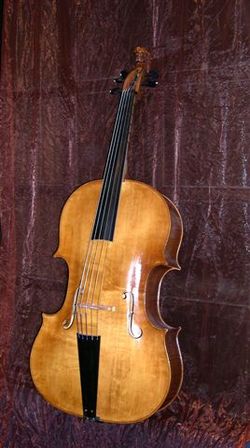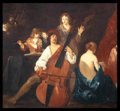Violone facts for kids
The violone (pronounced: "Vee-o-LOH-ne") is a very big string instrument that used to be used in the 16th and 17th centuries. It is like a double bass, but it belongs to the viol family. The name "violone" means "large viol". It was really a "double-bass viola da gamba". It usually had six strings, and the fingerboard had frets (like a guitar) which showed where to put the fingers of the left hand to make the notes. The bow was held underhand (with the palm of the hand facing up).
Usage
The violone is sometimes heard today in early music groups who are playing Renaissance and early Baroque music music. The instruments used today are usually ones that have been made recently to look and sound like the old ones.
History
The violone was the last member of the viol family to die out. When the other sizes of viol had been replaced by orchestras with violins, violas and cellos the violone was often used instead of a double bass. Bach used the violone in his cantatas. Eventually the violone was no longer used, and the double bass was used instead. The double bass still looks a little bit like the old viol because it has sloping shoulders and the strings are tuned in fourths.
Use of the name "violone" in organs
In organs "Violone" is the name given to a soft organ stop made of metal or wood, usually in the pedals.
Related pages
Images for kids
-
Some early double basses were conversions of existing violones. This 1640 painting shows a bass violone being played.
-
A violone or "great bass viol"; painting by Sir Peter Lely, Dutch-born English Baroque era painter, c. 1640, showing a large bass instrument of da braccio corpus form, but with a very wide fingerboard, played with underhand bow grip, and without an endpin
See also
 In Spanish: Violone para niños
In Spanish: Violone para niños



